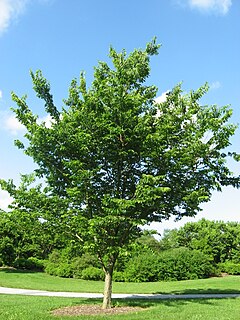
Cobra is the common name of various elapid snakes, most of which belong to the genus Naja.

Goldenrod is a common name for many species of flowering plants in the sunflower family, Asteraceae, commonly in reference to the genus Solidago.

Celtis is a genus of about 60–70 species of deciduous trees, commonly known as hackberries or nettle trees, widespread in warm temperate regions of the Northern Hemisphere, in southern Europe, southern and eastern Asia, and southern and central North America, south to central Africa, and northern and central South America. The genus is present in the fossil record at least since the Miocene of Europe, and Paleocene of North America and eastern Asia.
Hackberries is a common name for

Celtis occidentalis, commonly known as the common hackberry, is a large deciduous tree native to North America. It is also known as the nettletree, sugarberry, beaverwood, northern hackberry, and American hackberry. It is a moderately long-lived hardwood with a light-colored wood, yellowish gray to light brown with yellow streaks.

Asterocampa, commonly called hackberry butterflies or American emperors, is a genus of butterflies in the family Nymphalidae found mainly in North and Central America and the Caribbean.

Asterocampa celtis, the hackberry emperor, is a North American butterfly that belongs to the brushfooted butterfly family, Nymphalidae. It gets its name from the hackberry tree upon which it lays its eggs. The hackberry tree is the only host plant for A. celtis and is the food source for larvae.

Celtis reticulata, with common names including netleaf hackberry, western hackberry, Douglas hackberry, netleaf sugar hackberry, palo blanco, and acibuche, is a small- to medium-sized deciduous tree native to western North America.
C. sinensis may refer to:
C. japonica may refer to:

Hackberry is an unincorporated community in Mohave County, Arizona, United States. Hackberry is located on Arizona State Route 66 23 miles (37 km) northeast of Kingman. Hackberry has a post office which serves 68 residential mailboxes with ZIP code 86411.
C. occidentalis may refer to:
C. laevigata may refer to:

Lycium berlandieri is a species of flowering plant in the nightshade family known by the common name Berlandier's wolfberry. It is native to Mexico and the south-western United States from Arizona to Texas.

Asterocampa leilia, the Empress Leilia, Leilia hackberry butterfly or desert hackberry, is a species of butterfly in the family Nymphalidae.
The Goldfield Mountains of Arizona are located adjacent to the Superstition Mountains, between Usery Pass and Canyon Lake (Arizona). They are less known because of the Superstition Mountains, which are taller and more visible, and contain Canyon Lake (Arizona), which is a huge historic site. The southern part of the Goldfield Mountains used to be a big mining district in 1893. Even though the mining is done, the Goldfield Mountains are still a treasure themselves. These mountains are now big for hiking.

Celtis ehrenbergiana, called the desert hackberry or spiny hackberry, is a plant species that has long been called C. pallida by many authors, including in the "Flora of North America" database. It is native to Arizona, Florida, New Mexico and Texas, and to Latin America as far south as central Argentina. It grows in dry locations such as deserts, brushlands, canyons, mesas and grasslands.

The Beach Mountains are located on privately owned land roughly 3 miles (5 km) north of Van Horn in southwestern Culberson County, Texas. The maximum elevation reached is 5,827 feet (1,776 m) above sea level. The Beach Mountains occupy a roughly circular area with a diameter of approximately 8 kilometres (5.0 mi), rising 550 metres (1,800 ft) above the surrounding desert. Narrow passes separate the Beach Mountains from the Baylor Mountains to the north and the much larger Sierra Diablo range to the northwest.
This page is based on this
Wikipedia article Text is available under the
CC BY-SA 4.0 license; additional terms may apply.
Images, videos and audio are available under their respective licenses.










